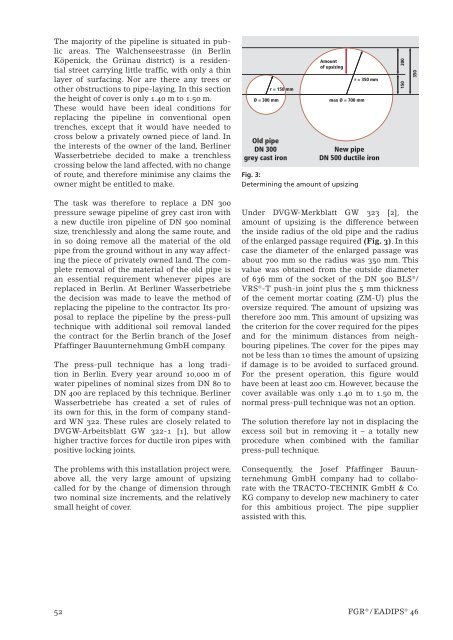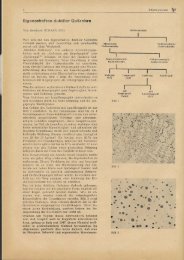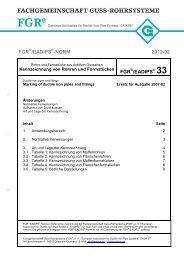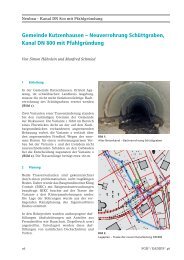Download PDF file
Download PDF file
Download PDF file
- TAGS
- download
- 81.169.135.155
You also want an ePaper? Increase the reach of your titles
YUMPU automatically turns print PDFs into web optimized ePapers that Google loves.
The majority of the pipeline is situated in public<br />
areas. The Walchenseestrasse (in Berlin<br />
Köpenick, the Grünau district) is a residential<br />
street carrying little traffic, with only a thin<br />
layer of surfacing. Nor are there any trees or<br />
other obstructions to pipe-laying. In this section<br />
the height of cover is only 1.40 m to 1.50 m.<br />
These would have been ideal conditions for<br />
replacing the pipeline in conventional open<br />
trenches, except that it would have needed to<br />
cross below a privately owned piece of land. In<br />
the interests of the owner of the land, Berliner<br />
Wasserbetriebe decided to make a trenchless<br />
crossing below the land affected, with no change<br />
of route, and therefore minimise any claims the<br />
owner might be entitled to make.<br />
The task was therefore to replace a DN 300<br />
pressure sewage pipeline of grey cast iron with<br />
a new ductile iron pipeline of DN 500 nominal<br />
size, trenchlessly and along the same route, and<br />
in so doing remove all the material of the old<br />
pipe from the ground without in any way affecting<br />
the piece of privately owned land. The complete<br />
removal of the material of the old pipe is<br />
an essential requirement whenever pipes are<br />
replaced in Berlin. At Berliner Wasserbetriebe<br />
the decision was made to leave the method of<br />
replacing the pipeline to the contractor. Its proposal<br />
to replace the pipeline by the press-pull<br />
technique with additional soil removal landed<br />
the contract for the Berlin branch of the Josef<br />
Pfaffinger Bauunternehmung GmbH company.<br />
The press-pull technique has a long tradition<br />
in Berlin. Every year around 10,000 m of<br />
water pipelines of nominal sizes from DN 80 to<br />
DN 400 are replaced by this technique. Berliner<br />
Wasserbetriebe has created a set of rules of<br />
its own for this, in the form of company standard<br />
WN 322. These rules are closely related to<br />
DVGW-Arbeits blatt GW 322-1 [1], but allow<br />
higher tractive forces for ductile iron pipes with<br />
positive locking joints.<br />
The problems with this installation project were,<br />
above all, the very large amount of upsizing<br />
called for by the change of dimension through<br />
two nominal size increments, and the relatively<br />
small height of cover.<br />
52<br />
Ø = 300 mm<br />
r = 150 mm<br />
Old pipe<br />
DN 300<br />
grey cast iron<br />
Amount<br />
of upsizing<br />
max Ø = 700 mm<br />
New pipe<br />
DN 500 ductile iron<br />
Fig. 3:<br />
Determining the amount of upsizing<br />
r = 350 mm<br />
Under DVGW-Merkblatt GW 323 [2], the<br />
amount of upsizing is the difference between<br />
the inside radius of the old pipe and the radius<br />
of the enlarged passage required (Fig. 3). In this<br />
case the diameter of the enlarged passage was<br />
about 700 mm so the radius was 350 mm. This<br />
value was obtained from the outside diameter<br />
of 636 mm of the socket of the DN 500 BLS®/<br />
VRS®-T push-in joint plus the 5 mm thickness<br />
of the cement mortar coating (ZM-U) plus the<br />
oversize required. The amount of upsizing was<br />
therefore 200 mm. This amount of upsizing was<br />
the criterion for the cover required for the pipes<br />
and for the minimum distances from neighbouring<br />
pipelines. The cover for the pipes may<br />
not be less than 10 times the amount of upsizing<br />
if damage is to be avoided to surfaced ground.<br />
For the present operation, this figure would<br />
have been at least 200 cm. However, because the<br />
cover available was only 1.40 m to 1.50 m, the<br />
normal press-pull technique was not an option.<br />
The solution therefore lay not in displacing the<br />
excess soil but in removing it – a totally new<br />
procedure when combined with the familiar<br />
press-pull technique.<br />
Consequently, the Josef Pfaffinger Bauunternehmung<br />
GmbH company had to collaborate<br />
with the TRACTO-TECHNIK GmbH & Co.<br />
KG company to develop new machinery to cater<br />
for this ambitious project. The pipe supplier<br />
assisted with this.<br />
150 200<br />
350<br />
FGR® / EADIPS® 46
















